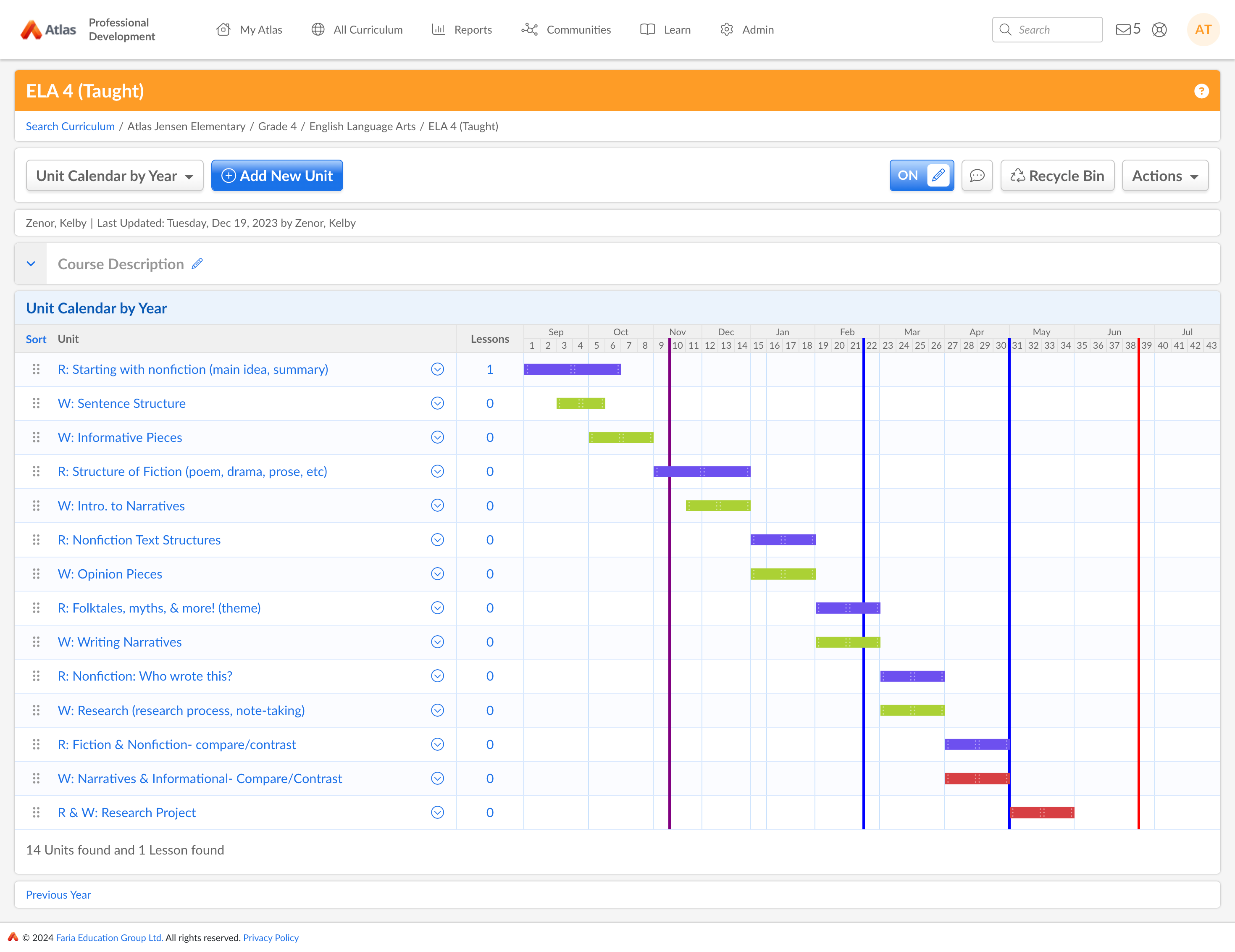Written by Megan Davenport, FariaPD
Sitting down to begin mapping your curriculum is a daunting task—where do you even begin? There are many entry points, but here I walk you through one way that the process can look in order to help you begin your own work!
Pre-Work
Assess Your Curriculum Beliefs: What do the teachers and administrators at your school believe about curriculum? At my school, we outlined the following beliefs:
- Good curriculum is spiraled and continuously reviewed.
- Good curriculum is research-based and standards-aligned.
- Good curriculum is focused and provides clear instruction.
Why does this matter? I need to make sure that my curriculum is meeting these beliefs. It doesn’t really matter how I begin to outline my year as long as I am staying true to these core principles.
Gather Your Materials: In my case, I will be using the Common Core State Standards and my ELA textbook as a foundation for my curriculum. To begin, I need a print out of my standards, a highlighter, and a pen. Additionally, I need my teacher’s manual to use as a reference.
Determine Your Structure: Mapping ELA at the elementary level is hard! Though reading, writing, and grammar are always difficult to capture, early elementary can be especially tricky when thinking about all of the direct instruction that needs to happen around phonics, vocabulary, spelling, speaking, and more. This blog post explores a few options. In my example, I have separate instructional blocks for reading and writing during the day/week, so I will choose to have separate reading and writing units within the same ELA map.
Getting Started: How do you begin the task? Below I broke down my process into five steps. Please note that I completed steps 1-4 for my reading literature standards, repeated steps 1-4 with the reading informational text standards, and then repeated them again with my writing standards.
STEP 1: DEEP DIVE INTO THE STANDARDS.
My first step is to do a close-read of the standards, and to highlight key concepts, terms, and ideas. This will help me process what my students need to learn throughout the year. I also like to make notes in the margins to keep track of any thoughts, and to record connections I make while reading.
STEP 2: GROUP THE STANDARDS.
Once I have read through the standards, I think about the logical groupings that will help my students master the concepts. In my example, I chose to have most of my units focus specifically on literature or informational text concepts. This is one approach, though you may choose to group similar concepts together and have units that cover both fiction and nonfiction. There isn’t any right or wrong answer, so have fun with it! Think about the standards that will complement each other and fit your instruction.
STEP 3: CREATE YOUR UNITS.
Once the standards are grouped together, go ahead and create the units! You can always enter functional unit titles as a working draft—they are easy to change down the road. I also like to align the standards as soon as the units are created so that my thought-work is preserved.
STEP 4: CONSIDER THE TEXTBOOK.
Now that I have my units started, I like to review the textbook and determine which anchor texts I would like to use for each unit. This step provides a chance to double-check that the groupings I picked will complement each other. If the anchor texts aren’t a good fit for the units I’ve started, it is not too late to do a little rearranging!
STEP 5: REVIEW & PACE.
At this point, I can take a moment to review my units to ensure that everything still makes sense and is a good match for my teaching style and class goals. I can then take the time to think about how long I expect each unit to take, and when I would pace them throughout the year. In my course, I like to alternate between fiction and nonfiction units, so I can now make sure my calendar reflects that preference. Of course, if you choose to weave them together, you are free to do so.

Frequently Asked Questions
Why not just follow the textbook exactly? The textbook was a great resource for me, but I found that it moved too quickly for me and my students, and I didn’t like the order in which they introduced new concepts and skills. As such, I plan to restructure my course to move at my own pace, while building in the use of resources from the textbook and other resources that I find on my own.
How many standards per unit? I chose to only align the standards to each unit that will be a major focus of my direct instruction. This does not mean that I am not continuing to spiral additional standards throughout my units for review. I find that my teaching is best when I focus on the new concepts that my students will be learning. We will review our past learning as we discuss and interact with the text, but I chose not to align to those standards so that I can intentionally focus on my direct instruction. I will include references to the additional standards in my learning activities, and I can also align them to assessments for additional tracking.
Did you skip some standards when you started creating the units? Yes. Because I am just starting my units, I ensured that I am covering all of the Literature, Informational Text, and Writing standards for the structure of my course. The Speaking & Listening and Language standards will be added later as I outline my activities.
How should I structure my Content and Skills? As you consider the phonics, vocabulary, grammar, spelling, and any other components that are a part of your language instruction, you may want to think about adding subheadings to your Content and Skills sections so that you can explicitly address all of these topics. As we are starting to outline our course, we will not get into this depth of detail, but it is something to consider as a next step.
What are some other ways to structure my units?
Thematic units: Some teachers start with a topic or theme, and then add the standards & concepts to fit within that theme. For example, you may have several stories and resources about animals, and thus create a unit that is “All About Animals.” Within that unit, you can choose which standards to group together as you read stories with animals as characters, and informational text about animals. We might also recommend adding a bit more detail about the focus of the unit, such as “All About Animals: Summarize.”
Integrated units: Especially as students get older, teachers may choose to have reading, writing, grammar, and all language topics within the same unit. If this is the case, you can go through a similar process to that outlined above. However, you will also want to consider the reading and writing standards in the grouping stage.

